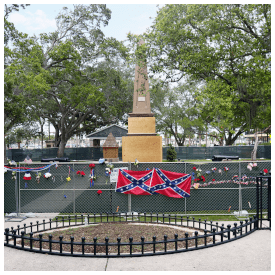
Local residents and Historic City visitors stopped in St Augustine’s Plaza de la Constitution today; many of whom brought with them a bouquet of flowers, a hand lettered sign or greeting card, a Gadsden flag, the Confederate battle flag, or even the red, white and blue that we fly today. Sunday was the day set aside for a “Fill the Fence” event organized by Jill Pacetti and many from the city’s Menorcan cultural community.
In the last regular meeting of the St Augustine City Commission Mayor Tracy Upchurch advanced his plan to let city taxpayers pay an estimated $160,000 to a house moving company in Green Cove Springs to relocate the 1879 memorial that honors local veterans who lost their life during the American Civil War. On a 3-2 split vote, the mayor, vice-mayor Leanna Freeman, and commissioner Nancy Sikes-Kline decided to remove the cenotaph erected with private donations raised by the Ladies Memorial Association of St Augustine.
Police Chief Barry Fox reported to Historic City News editor Michael Gold this evening that a “miscommunication” between him and his day sergeant led to nearly a dozen city police officers showing up in the Plaza before noon. Fox said that he had discussed plans with Pacetti at length. At 8:00 p.m., when the event wrapped up, the participants were expected to leave, and the city would remove the offerings left at the site during the day.
Some 38-living descendants of the forty-six soldiers whose names appear on two sides of the memorial came through the Plaza this morning to pay their respects and show some love for their ancestors as they have done, under happier circumstances, over the past 140+ years.
Instead, relatives and visitors became embroiled in arguments with police officers who began cutting down flowers, signs, and American flags of assorted sizes, about eight-hours ahead of schedule. The officers allowed much of the debris to fall on the ground around the temporary chain-link fence that protects the memorial while it sits in purgatory. While several officers continued cutting down the materials, others shoved the display pieces, including the American flag, into plaza trash receptacles.
Sunday, the 38-descendants were joined by the Veterans Council of St. Johns County, and the Ancient City Chapter of the Military Officers Association, in a lawsuit and plea for an emergency temporary restraining order to put the brakes on city manager John Regan’s hasty implementation of the three commissioner’s order.
The lawsuit seeks a temporary injunction until the Historic Archaeological Review Board can study and determine the feasibility of moving the ancient brick and stucco structure. An “archaeological dig” may be required before the structure can be legally moved. Also, the memorial is in an area that was designated as a “national historic landmark” in 1970. As the lawsuit progresses, the plaintiffs will research any additional protection that designation may include.
Fox told Historic City News that when he discovered what happened to the American flags, he sent someone to retrieve any flags they could still find in the garbage. “The flags we collected at the memorial are here at the police department,” Fox told Gold during their call. “You know both my mother and father were career military and neither I nor anyone in my department meant any disrespect when they removed the flags.”
Not all Confederate memorials in Florida are the same. In research available from William B. Lees, PhD, RPA with the Florida Public Archaeology Network and the University of West Florida, and Frederick P Gaske, MA, former State Historic Preservation Officer, Historic City News learned that the St Augustine memorial, originally erected in 1872 and later reconstructed in 1879, is the second-oldest standing memorial.
The oldest, erected a year earlier, is in DeFuniak Springs. These two memorials are to fallen local soldiers. Neither aggrandizes nor purposefully vindicates the cause of the confederacy. They contain no Confederate symbols or reference Confederate leaders. Nonetheless, the memorial to the city’s Civil War dead is important. It reflects the reality of the Reconstruction-era government of Florida, which would not allow it to be erected on public property before the end of Reconstruction.



